Unleashing the Power of Dayparting in Amazon Ads for Sellers
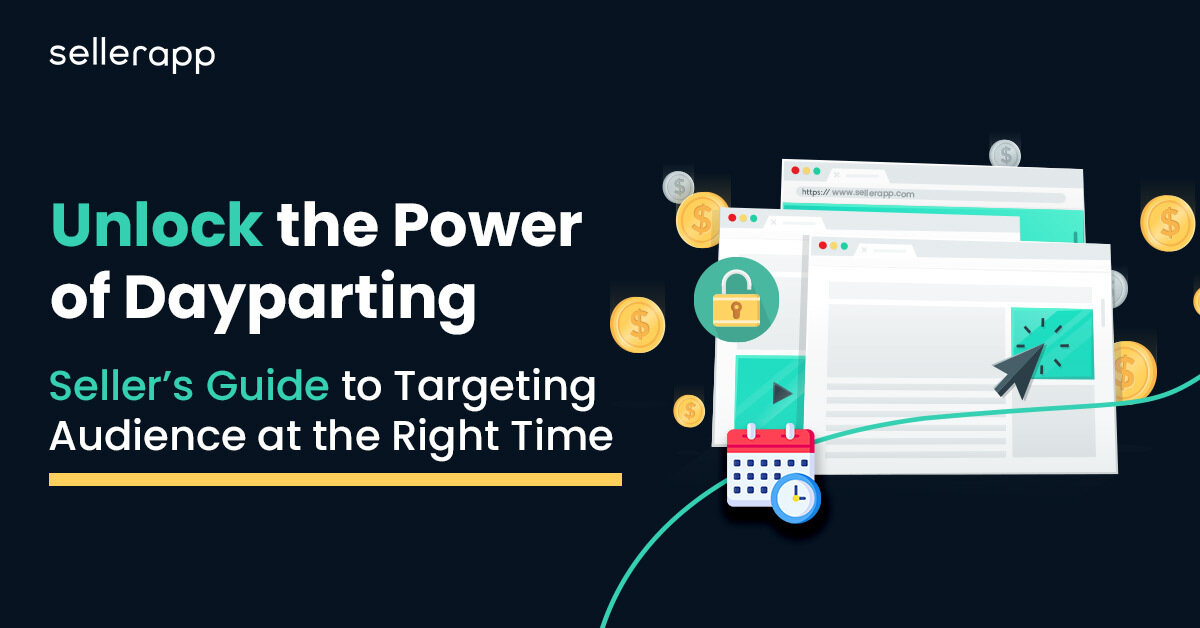
As an Amazon seller, you know how important it is to make the most of your ad budget.
You spent hours researching the right keywords and optimizing your campaigns.
But despite your best efforts, you just can’t seem to get the conversions you want.
Sounds familiar?
You’re not alone. Many advertisers struggle with wasted ad spending and low conversion rates for their campaigns.
But what if we tell you there is a way to show ads to shoppers when they’re more likely to buy your products?
Enter dayparting on Amazon. With dayparting, you can set up different ad budgets for different times of the day based on the peak/off-peak sales window and get more conversions.
Don’t just take our word for it.
Meet Sarah, an Amazon seller who was struggling to get the results she wanted from the ad campaigns. Frustrated and ready to throw in the towel, Sarah decided to try dayparting.
Thanks to dayparting, she was able to bid only during the times when her customers were online and ready to make a purchase.
Result?
Her conversion rates skyrocketed, and she finally made the most of her ad budget.
Not just Sarah, we’ve seen other brands also reduce the wasted ad spending by a significant amount with dayparting.
If you’re also tired of wasting ad budget and low conversion rates, dayparting might be the solution for you.
This blog will explore all the benefits of dayparting and how to set it up for success.
Let’s get started!
Quick Peak at the article:
- What is dayparting why It’s important?
- What are the benefits of using dayparting on Amazon?
- How to efficiently use dayparting
- How to use SellerApp dayparting – step-by-step Guide
- What are the limitations of dayparting?
- Things to keep in mind before using dayparting on Amazon?
- Final Thoughts
What Is Amazon Dayparting and Why It’s Important?
Dayparting or Amazon Ad scheduling is an advanced advertising feature that helps you distribute or adjust your daily ad budget on campaigns for certain times of the day to maximize RoAS and reduce wasted ad spending.
For example, if your products sell better in the evenings, you can allocate a higher ad budget at that times and a lower budget for the morning hours. This helps you to target the most receptive audience with relevant ads and increase the chances of conversion.
In addition to targeting specific times of the day, dayparting also helps you adjust campaigns for different seasons or events. For example, if you sell seasonal products, increase the ad budget around the holidays to take advantage of increased consumer activity.
Overall, by automating your ad budget management and targeting the most receptive audience, you can increase your chances of conversion and drive more sales for your business.
What Are the Benefits of Using Dayparting on Amazon?
There are numerous benefits of using Dayparting in your campaigns. Listed below are a few of them:
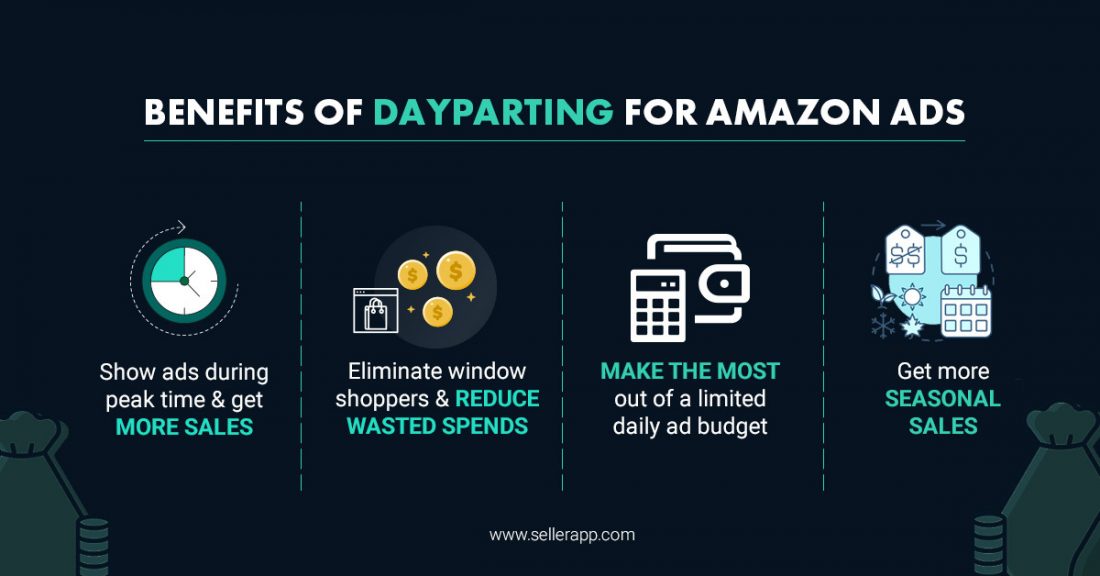
Show Ads During Peak Times
One of the main benefits of using dayparting is the ability to show ads during peak times.
In general, conversion tends to stay high from 6 pm to 12 pm on Amazon, when the shoppers have free time to browse and purchase products.
You can use dayparting to set up a high ad budget for your campaigns during this timeframe. It ensures ads are shown to high-converting shoppers and get more sales.
Eliminate Window-Shopping Traffic
In general, brands observe fewer sales at night, between 12 am to 5 am.
These are infomercial hours of the day. At this time, shoppers focus more on window shopping and discovering new products.
Reduce bids on campaigns during this time to ensure you are not wasting ad budget on non-converting audiences.
Note: Setting up dayparting depends on the target customer’s demographic. For example, Parents tend to shop after their children go to bed at night, after 10–11 pm.
So, if you’re selling a baby product, you might want to increase the ad budget after 11 pm to get the maximum sales.
Get More Sales During Shopping Events
Shopping events such as Prime Day, Black Friday, and the Q4 holiday season are the prime time for sellers to make good sales.
The demand and competition are fierce these days, and CPC tends to inflate by 2x-3x during these times. Your bids also need to rise at this time to win the top of the search positions and maintain sales velocity.
Dayparting can make this easy for you.
Set up a rule to increase bids by 20% for your high-converting campaigns from the 4th week of October to the 3rd week of December, and you’re all set for the Q4 holiday season to make big bucks.
Manage a Limited Daily Budget Effectively
Dayparting also lets you utilize a limited ad budget effectively.
Reduce the ad budget during sales downtime to conserve the total daily ad budget. And bid more aggressively during high-converting hours to align ad spends with customer buying behavior and get more sales.
Target the Ideal Customers
Increase budget with dayparting when the target audience is most active on Amazon.
For example, if you sell “Printer ink,” then the target customers are mostly business people, who might stay most active on weekdays, from 10 pm – 4 pm.
Increase the ad budget during that time to get maximum sales and avoid spending high during the rest of the days to maximize ROAS.
Get High Seasonal Purchases
This is self-explanatory. Let’s say you sell ‘umbrellas.’ The demand for this product is exceptionally high during monsoons and winter. On the other hand, during spring or summer, it has low demand.
Set up dayparting rules to boost the ad spend during these peak sessions to capitalize on the demand.
Now that you know the benefits of dayparting let’s understand when to create it.
How to Find Out When to Create Dayparting
If you’re thinking about creating dayparting campaigns, don’t start blindly.
There are several factors to consider before setting up dayparting rules.
What Is Your Campaign Goal?
Do you know what you want to achieve from your campaigns?
Is it to reduce wasted ad spending? Then it makes sense to reduce the ad budget during low-converting hours.
But if you’re in the product launch phase, the goal is to get maximum customer reach. Reducing the ad budget in low-converting hours isn’t a good strategy for expanding visibility.
How Long Your Customer’s Buying Cycle Is?
Does the product have a high price? Do the shoppers need to conduct extensive research before making a purchase?
If the buying cycle is long, you need to touch base with the customer at every stage of the cycle. Dayparting here isn’t a good strategy here.
Alternatively, if the product’s buying cycle is short, and the shoppers tend to buy in the spur of the moment, you can use dayparting to get more sales at the time shoppers are most active.
Recommended read: Amazon Power Seller Hacks to Maximize Profits.
Where Are Your Buyers Located?
Do your customers live in the same time zone?
Let’s say you’re operating the business from the US, and most of your customers are from the UK.
Then you can’t set up dayparting rules based on the US. You must learn when people in the UK most actively shop on Amazon and create dayparting based on that.
What Time Are Your Buyers Most Active At?
Track the previous sales history to understand which day of the week gets the maximum conversion.
Log in to your Seller Central account and go to Reports→ Business Reports → Sales and Traffic. Download the last six month’s business report.
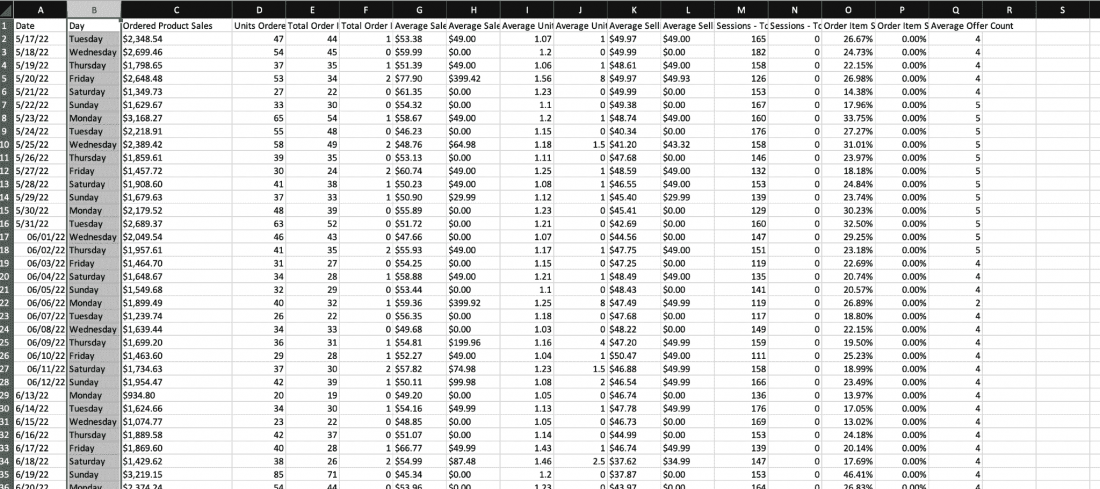
If you sort this data using a pivot table based on the days of the week, it would look something like this.
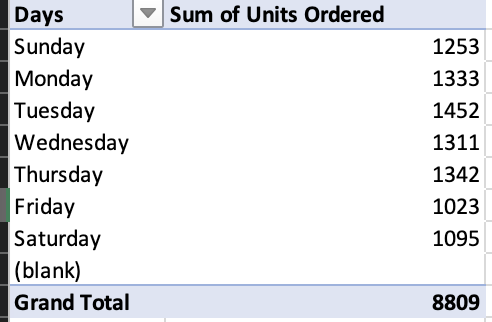
Identify which days of the week you’re getting more sales from this table. The sample data shows that the product is getting more sales on Monday, Tuesday, Wednesday, and Thursday.
You can also understand which time of the day you get more sales by looking at the daily sales trends on the sales dashboard (Business Reports).
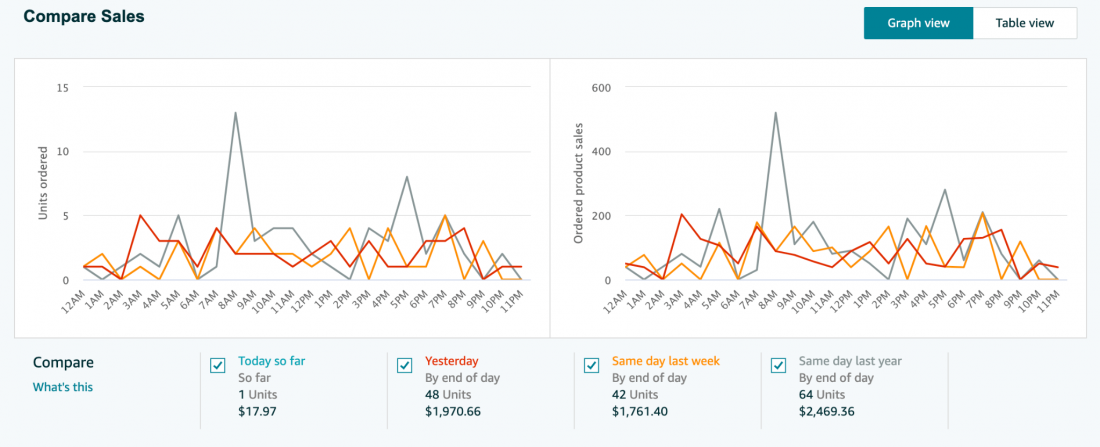
For example, this demo data show that most sales happen between 2–9 am and 3 – 10 pm.
How to Set Budget Rules With Amazon Campaign Manager
Now that you know when to create dayparting, let’s see how to create dayparting rules on Amazon.
- Log in to the Seller Central account and go to Campaign Manager → Budget.
- Select the campaign that you want to set dayparting for.
- Click the budget tab beside the campaign to set up rules. Then, click Add budget rule.
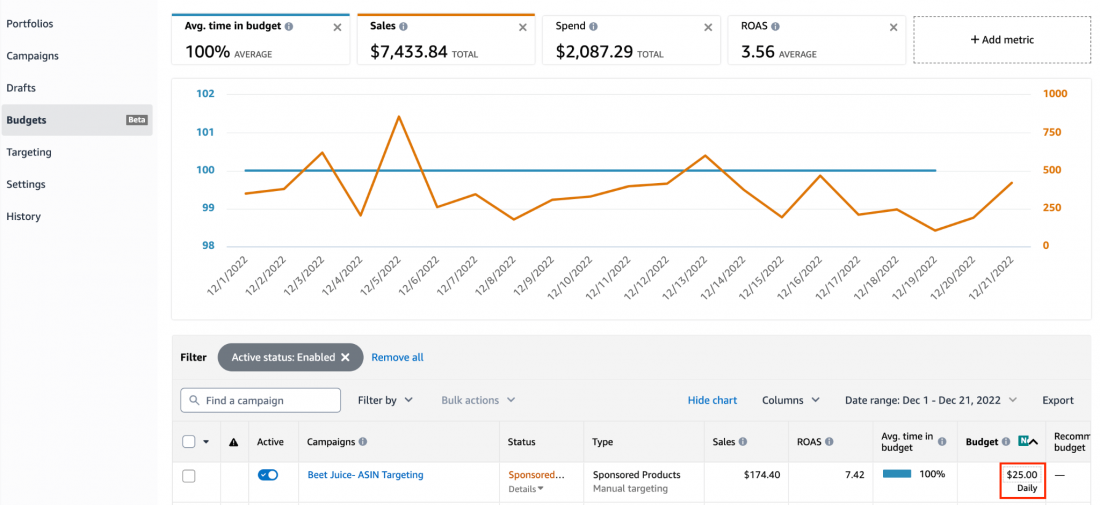
- Give a name to the rule, select the type “Schedule,” and give a start and end date.
For example, if you want to set up rules during Christmas and New Year, select the dates from Dec 24, 2022, to Jan 02, 2023.
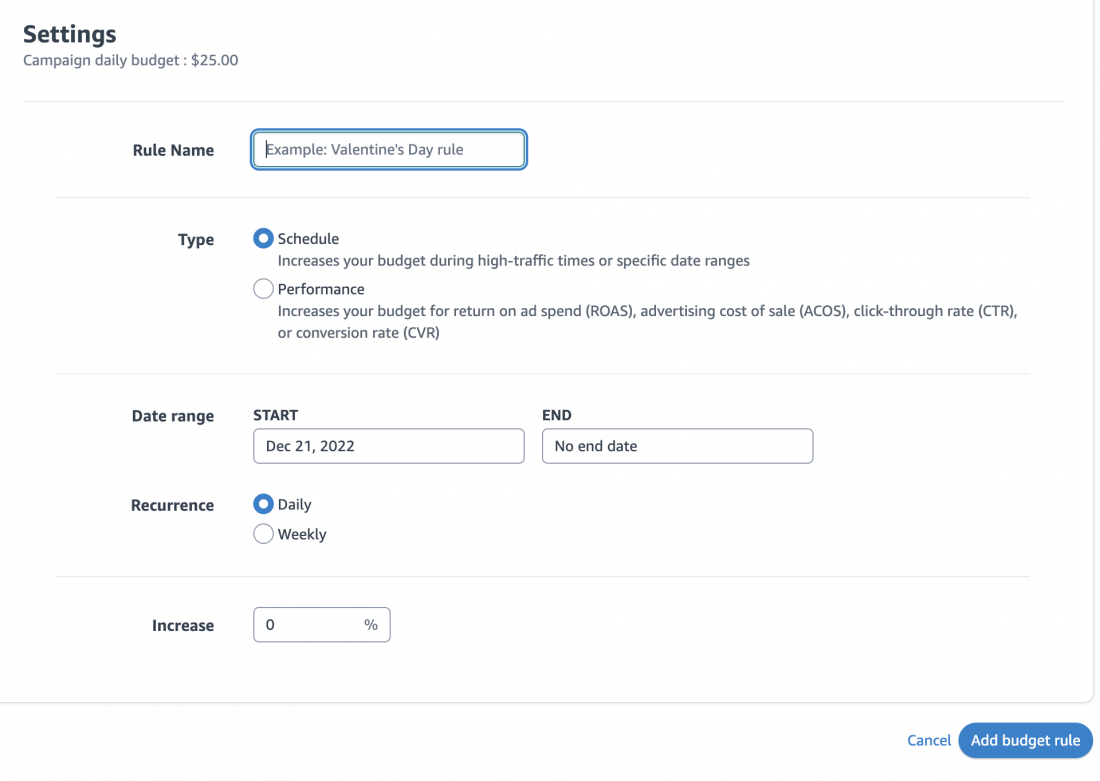
- Next, select Daily to apply the budget rules on all days of the week or Weekly to only apply rules on specific days of the week.
- Now, increase the bid by a certain percentage and click “Add budget rule” to create the dayparting rule.
Amazon’s budget rules, however, have some limitations. You can’t set up rules on the account level or on an hourly basis.
That’s where SellerApp comes in!
With the SellerApp Automation tool, you can set up hourly dayparting on your advertising account or campaign level with just a few clicks and reduce wasted ad spending.
Let’s see how!
How to Set Up Amazon Dayparting with SellerApp Automation Tool
Log in to the SellerApp dashboard and connect your Seller Central and advertising account to set up dayparting.
Go to Advertising → Automation → Dayparting from the left navigation bar.
Click “Create blank Dayparting rule.”
Here, you can choose to create dayparting on the account or campaign level.

Next, select the start and end dates for dayparting, and set the overall daily account budget.

In the next step, add a custom budget for different times on different weekdays based on historical data. Then review, enable the rule, and let the magic of dayparting unfold.
You can also send the dayparting rule to our PPC experts for review.
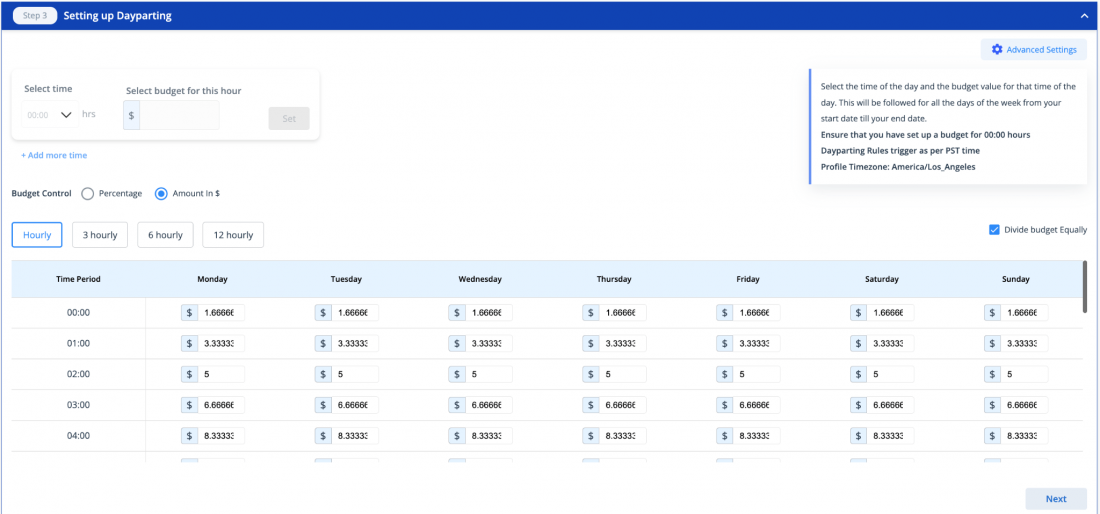
Sounds interesting?
Log in to the SellerApp dashboard now, and schedule your first dayparting rule.
Want to learn more about how to set up dayparting, you can look at this video:
Introducing: Dayparting in SellerApp Advertising | Amazon Ad Scheduling For Improved Targeting
Amazon Dayparting Best Practices
Effective dayparting is all about tailoring your campaigns based on customer behavior. Here are some best practices to do it effectively:
Avoid CPC Bid Rush
Most advertising managers would not adjust bids manually during the night.
This means the morning crowd, awake and active, is driving bids on Amazon.
If you’re a beginner trying out dayparting for the first time, it’s a good idea to avoid testing campaigns during this time.
Instead, try adjusting your bids during the afternoon or evening when there is less competition.
This way, you can decrease ad spending while maximizing ROAS.
Gather More Data From Amazon Retail Analytics(ARA)
Amazon-registered vendors can use the Amazon Retail Analytics dashboard to look at hourly sales data on the ASIN level.
Pick your top 5 – 10 products, and identify their hourly sales trends. This would help you understand customers’ behavior better and create accurate dayparting rules for your campaigns.
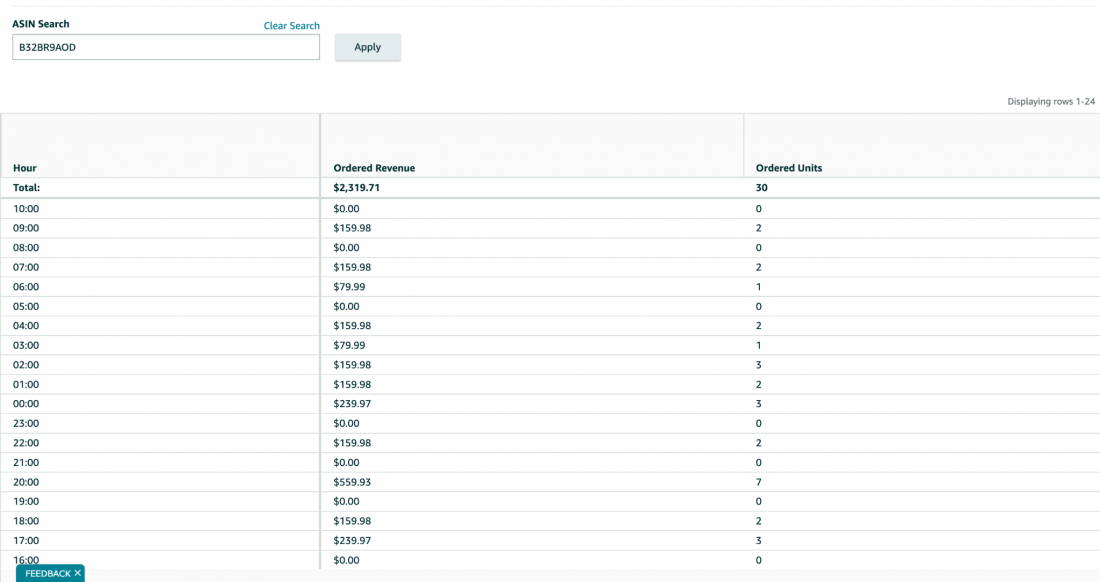
Note: ARA considers the entire sales flywheel, from organic to paid results, and gives you a holistic view of ASIN-level sales performance.
Sync Dayparting With Lightning Deals
Using Amazon lightning deals combined with dayparting is an excellent way to increase sales in the short term.
Set up a high ad budget during the lightning deals events and get more visibility on your products and, in turn, more sales.
Test the Dayparting Rules
Constant testing and optimization is the key to a good dayparting strategy.
No two brands have the same audience, and no two audiences have the same buying behavior.
A/B test multiple identical campaigns by setting up high ad budgets at different hours.
Let’s say campaign A has a high ad budget from 10 am to 12 pm. And campaign B has a high ad budget from 6 pm to 9 pm.
After running ads for one or two weeks, you see campaign A gets 15% ACoS, whereas campaign B gets 20% ACoS.
From this test, you can understand that focusing on 6 – 9 pm is the best way to reduce ACoS and increase profitability for your campaigns.
Things You Should Keep In Mind Before Setting Up Amazon Dayparting
Like all good things in life, dayparting also comes with some constraints.
You can’t set up dayparting for all your campaigns blindly. Keep the following limitations in mind before starting:
Amazon Hourly Data Is Not Granular
The hourly sales and conversion rate data are necessary to create an accurate dayparting rule.
But, the Amazon advertising console only gives daily data, which is insufficient to create hourly dayparting.
An alternative way is to monitor the daily units’ trend from the Sales Dashboard manually for a week or two and note down the sales patterns.
Amazon Shows Inaccurate Data With Attribution
Most products have a 7 – 14 days attribution on Amazon. That means if a shopper clicks on an ad on Monday and buys the product on Friday, the sale will be attributed to the click on Monday.
That’s why we suggest looking at extended historical sales data for at least a month to understand the sales trends accurately before setting up dayparting.
You Lose Potential to Reach Vital Touch Points
As we discussed in our Amazon full-funnel advertising guide, the customer’s journey is not always linear.
Amazon sellers need to show their ads to shoppers at every stage of the customer journey to maximize the chance of conversions.
With dayparting, however, you limit your chance to chat with shoppers at each step of the journey, which results in a reduced conversion rate of your product.
Dayparting May Not Apply to All Products
If the product has a high demand throughout the day or if the product has a broad target audience who shops at different times, dayparting may not be the right strategy.
Final Thoughts
At the end of the day, dayparting is one of the optimization strategies to help you reduce wasted ad spending and maximize ROAS.
It’s nowhere near a “be all-end all’ strategy that magically clears all your problems with PPC. We recommend A/B testing campaigns to figure out what works best for you and your products.
Here are some recommendations for dayparting from the blog:
- If you have a low budget and it doesn’t last the whole day, use dayparting to turn off campaigns during infomercial hours (12–6 am).
- If your campaign ACoS is higher than the target ACoS, and bid adjustments don’t work, use dayparting to reduce wasted ad spends and lower ACoS further. Of course, you can always use SellerApp’s free Amazon PPC ACOS Calculator to quickly keep track of your ACOS.
- Audit PPC campaigns regularly to track any changes in shopping behavior and fine-tune the dayparting rules if needed.
So, when are you setting up dayparting for your campaigns? Comment below and tell us how it goes!
Have more questions about dayparting? Contact us, and our team of experts will set up dayparting to improve ROAS for your business.
Additional Guide:
Strategies CPG brands need to market new product launches on Amazon.
The Power of Digital Shelf Analytics for E-Commerce Success
How to Select Amazon Seller Name?


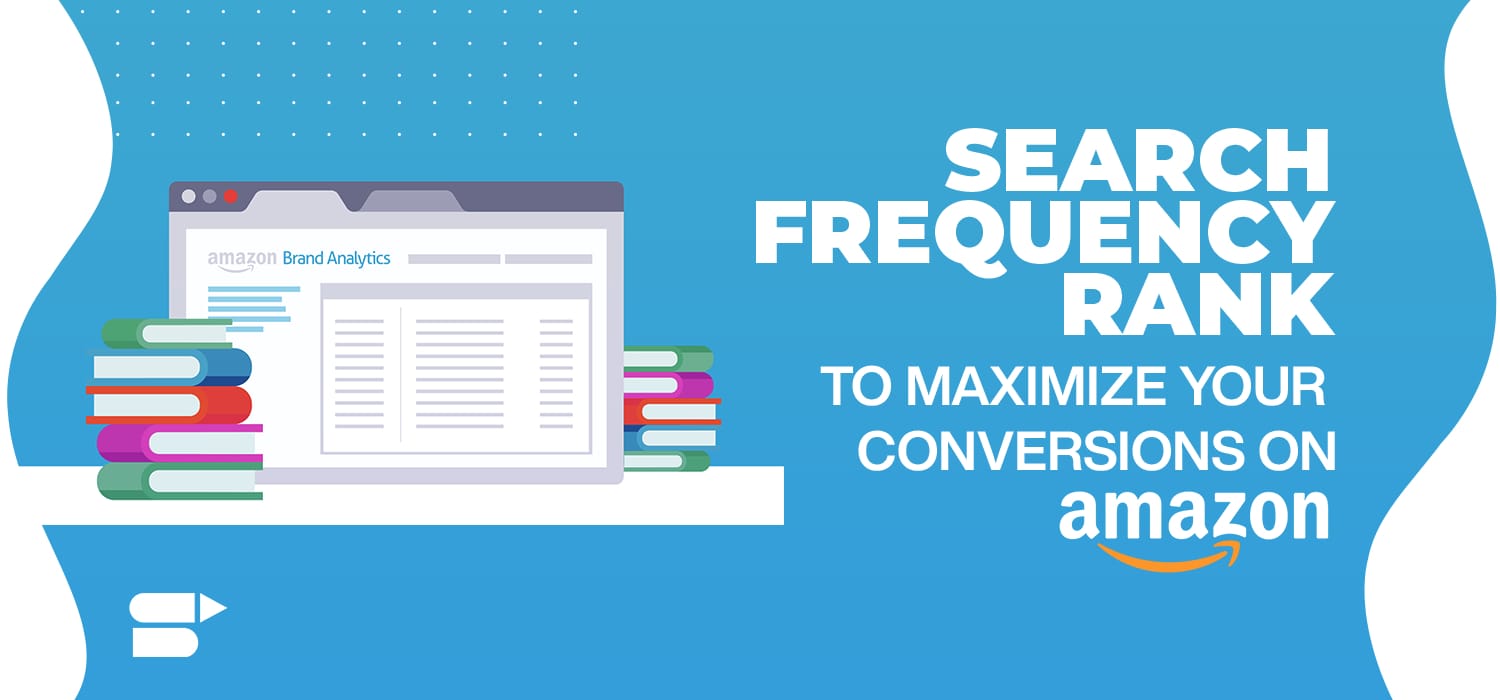
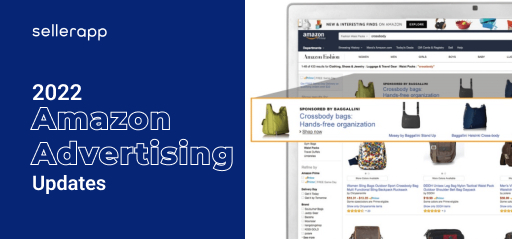







Silas
December 27, 2022Thanks for the great article.
Royal
December 27, 2022Great Post, Thanks for sharing this amazing blog.
Eleanor
December 27, 2022Enjoyed reading this, very good stuff, thank you.